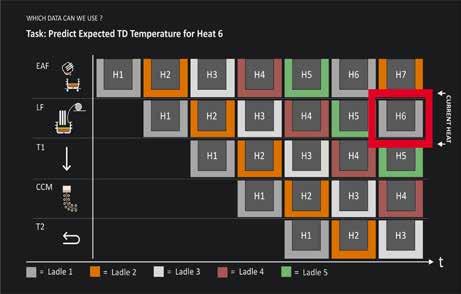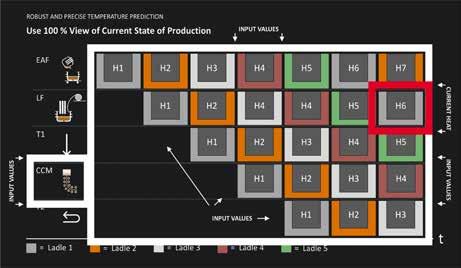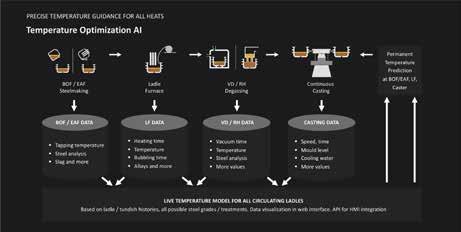
7 minute read
Application of AI to temperature optimization
Application of AI to temperature optimization in steelmaking
Precise temperature control in steelmaking from BOF/EAF via secondary metallurgy to the caster is mandatory for both process stability and solidification conditions for required cast product quality. The temperature behaviour of the steel in a ladle depends on a large variety of variables. It is impossible for conventional models to exactly consider all upcoming parameters and uncertainties which are necessary to implement precise temperature guidance
Advertisement
AUTHORS:Dr. Falk-Florian Henrich, CEO & Founder and Dr. Otmar Jannasch, VP Metallurgy, Smart Steel Technologies GmbH, Berlin
Smart Steel Technologies (SST) offers the Artificial Intelligence-based software SST Temperature Optimization AI, which includes precise temperature models for the whole steelmaking process based on advanced Machine Learning technology. Based on the increased precision provided by Smart Steel Technologies, temperature buffers are reliably minimized, thus lowering energy consumption, reducing CO 2 footprint and increasing casting stability. At the same time, the software provides a solid basis for optimization of timing and the analysis of irregular temperature deviations.
Fundamental Differences to Conventional Process Optimization Conventional process optimization is based on hand-written formulas and averaged measured values per unit. High-resolution time series are reduced to a single number. This over-simplification results in permanent information loss • Complex temperature curves are reduced to a handful of numbers. • Thermal behaviour of ladles is reduced to one number. • Interdependencies in steel production are complex and non-linear. For instance, subtle deviations in timings may be averaged away. The conventional approach of process optimization requires manual tuning of models over years that must be redone each time substantial parts of the process are modified.
Further increase in productivity and quality require the application of advanced non-linear methods to high-resolution data. This is the approach of Smart Steel Technologies: • Full processing of time series information without information loss • Multivariate modelling including all Level 1 and Level 2 signals
• Implementation of today’s most successful supervised learning methods in steel production • Installation of profound steel production know-how in all models Smart Steel Technologies routinely processes thousands of process signals, automatically extracts relevant process parameter combinations from mass
Temperature guidance from tapping to casting

Prediction of the steel-in-tundish temperature for heat H6 in ladle L1


Rough processes @ your fingertips... anywhere!
Your solution is Polytec
Visit us: TUBE Düsseldorf, Hall 7a, Booth E19
Process parameters considered by the calculation
data, and provides models specifically designed for analysing steel manufacturing processes.
Smart Steel Technologies substantially exceeds the market standard of Machine Learning and incorporates the latest research results from the field of Causal Inference into software development.
The metallurgical expertise and process know-how possessed by the team at Smart Steel Technologies is an integral part of its software. Because of this, metallurgically or technically irrelevant conclusions are excluded from analytical results. Process optimizations of SST contain appropriate actions with a robust cost-benefit ratio. A 360 Degree View of Steelmaking Smart Steel Technologies includes all relevant process parameters and measurement data into their model’s calculation, especially those parameters most recently set and measurements most recently taken. The diagram below highlights the prediction of the steel-in-tundish temperature for one heat H6 in ladle L1 while it is treated in the ladle furnace. In the running casting sequence, the heats H1 in ladle L1, H2 in L2, and H3 in L3 have already been cast. At the time of the prediction, heat H4 in ladle L4 is being cast, while heat H5 in ladle L5 is on its way from the ladle furnace to the continuous caster.
For the calculation of the temperature prediction for heat H6, Smart Steel Technologies considers the following parameters according to the diagram below: • All process-related parameters and measured data starting with tapping of heat H6 at EAF/BOF • The ladle history of ladle L1; the course of the temperature during all previous cycles of ladle L1, i.e.,
ProSpeed ® LSV-2100

Digital speed and length measurement with laser precision
The next generation optical speed and length sensor ProSpeed® LSV-2100 is designed to reliably perform even under harsh conditions. Thanks to its enhanced connectivity, the control over your production process is at your fingertips – anywhere and anytime. Digitize your process – with ProSpeed®.
during processing and casting of the heat H1 in L1 • The history of the tundish used in the running casting sequence • The position of the current heat H6 within the running casting sequence • The circumstances of the running casting sequence, in particular, at the time of the prediction, the tundish temperatures for the running heat H4 that have already been measured Based on measured data, the Smart Steel Technologies temperature model will, via machine learning, be automatically fit to the specific properties of each melt shop: its specific process routes, its equipment and its produced steel grades. The supervised self-learning system permanently improves the model optimization heat by heat, day by day. The following schema depicts the data flows and operational principles of SST Temperature Optimization AI. Temperature Guidance at BOF/ EAF, LF, and Caster Temperature guidance is implemented as follows at BOF or EAF, LF and at the casting machine.
Electric Arc Furnace: Optimization of Energy Input During Flat Bath Phase
During the flat bath or superheating phase, electrical energy is introduced to the steel via electrodes. At the same time, carbon and oxygen, which reacts to CO, is injected to form a foamy slag. This and the carbon loss of the electrodes introduce chemical energy to the steel. At the beginning of the flat bath phase, the following temperatures are computed by SST: • Expected actual tapping temperature • Expected casting-end temperature (last actual tundish temperature at the time when the ladle is closed) • Recommended optimal EAF tapping temperature The software derives recommendations for the operator based on the difference between recommended optimal tapping temperature and expected actual tapping temperature. Both temperatures and recommended changes are displayed in the main HMI. Thus, the operator can set setpoints.
Further, the SST Temperature Optimization AI software provides extensive browser-based visualizations to analyse
Principles of the SST Temperature Optimization AI

the correlation between tapping temperature and oxygen activity.
Basic Oxygen Furnace: Optimization of Dynamic Decarburization Phase
At the end of the main decarburization phase, a sample is taken to determine temperature and chemical analysis of the steel. Based on these values, the dynamic decarburization is controlled in terms of oxygen flow, lance height and duration to achieve the final or tapping carbon content and temperature.
The carbon content at this point is already low. Further increase of the steel temperature by carbon and even iron oxidation appears during the dynamic solidification compensated by the addition of cooling agents upon request. In the end, a reduction phase takes place. At the sample taking time, the following temperatures are computed by SST. • Expected actual tapping temperature • Expected actual ladle furnace entry temperature • Expected casting-end temperature (last actual tundish temperature at the time when the ladle is closed) • Recommended optimal BOF tapping temperature Upon the difference between recommended optimal tapping temperature and expected actual tapping temperature the software provides recommendations to minimize this difference: • Optimization of the dynamic decarburization phase in terms of duration, oxygen flow and lance height • Minimization of cooling agent addition and oxygen consumption Predictions and recommended changes are displayed in the main HMI for easy handling.
Ladle Furnace: Optimization of Energy Input During Electrical Heating Directly at the availability of ladle furnace entry steel analysis and steel temperature, the following temperatures are computed by SST: • Expected actual heating end temperature • Expected casting-end temperature (last actual tundish temperature at the time when the ladle is closed) • Recommended optimal heating-end temperature (the temperature at the end of LF heating) Upon the difference between recommended optimal heating-end temperature and expected actual heating end temperature, the software provides recommendations displayed in existing HMI to minimize this difference.
Casting Machine: Prediction of Tundish Temperature for Current and Upcoming Heat At the caster, the following temperatures are computed by SST: • Casting-end temperature of the current heat • Casting-end temperature of the upcoming heat • Expected actual ladle furnace exit temperature for the ladle being processed in the ladle furnace directly after the end of the heating The software permanently updates all temperature calculations and can provide a prediction of the full tundish temperature curve. All outputs of the software are displayed in the main HMI. Thus, the operator can adapt setpoints.










